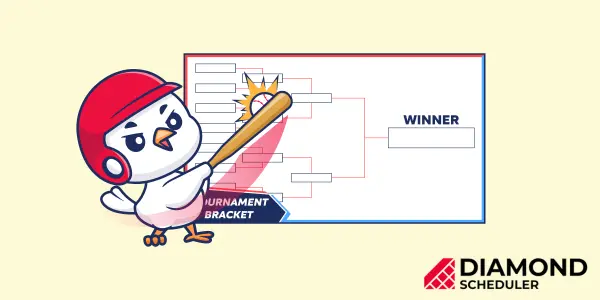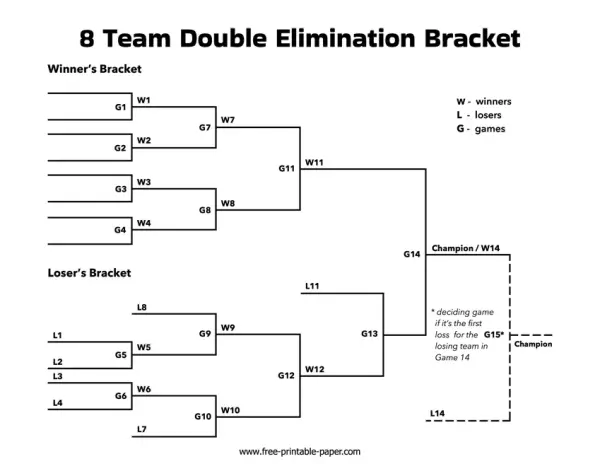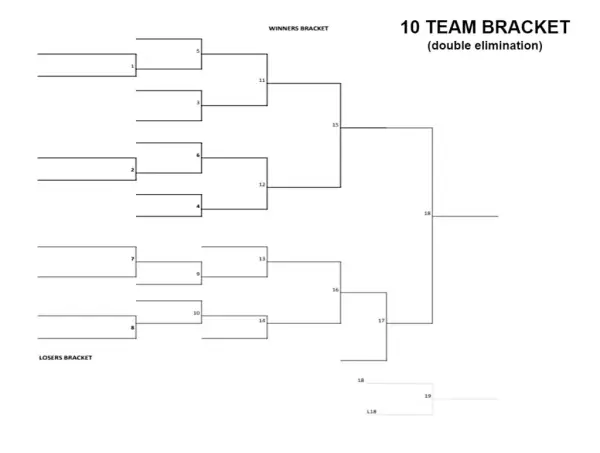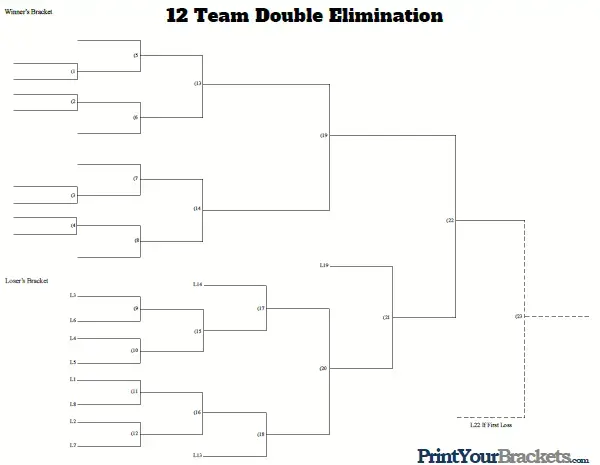
The Ultimate Tournament Guide to Double Elimination Brackets
Have you ever wondered how sports leagues keep the thrill of winning alive during a tournament? The secret lies in the art of effective scheduling, whether it's the fast-paced excitement of basketball or the strategic maneuvers of futbul (soccer).
Even the thunderous clashes of martial arts. A well-designed tournament structure can make all the difference. But what if there was a format that gave teams a second chance? A format that intensified the competition.
But how does it all work? In a double-elimination tournament, each team gets not one but two chances to prove themselves. The first game unfolds within the main bracket. Here opponents clash, winners advance, while losers descend to the losers bracket.
This is where the magic happens. The losers are not eliminated but instead fight amongst themselves. They are all vying for a chance to reclaim glory. The team within the losing bracket that advances earns the right to challenge the winner of the winner's bracket in a final showdown—the league’s favorite vs the underdog.
This system has found its place in various competitions worldwide, from the NCAA college basketball tournament to eSports extravaganzas. This article will look at their structure and advantages. It will become clear why double-elimination tournament formats have become a favorite amongst tournament organizers and opponents alike.
Understanding the basics of single-elimination brackets
Before we can look at double-elimination brackets, we need to understand single-elimination brackets. What they are and how they work. The basic premise of the single elimination system is that you can only lose once. Teams only have one chance. It's a very simple system. Teams win, or they go home.
When teams participate in a single elimination tournament, there is no room for mistakes, adding a level of excitement. The sudden death aspect of the tournament leads to some nail-biting competition. There's a special thrill due to the unpredictability of the system. One victory can change everything. A team that wasn't thought of as a favorite can build momentum due to one bad day for the strongest in the field.
The flip side of the coin is that the loss of one single game can have a huge impact. The defeated will face the agony of elimination, shattering dreams.
Introducing double-elimination brackets
Definition and explanation of double-elimination tournament brackets
So, how does the double-elimination bracket format work? Well, it provides two paths in which to take part, thus providing two outcomes. On the one hand, you have the winners bracket. And teams that win their matches continue in this bracket. Teams that lose move to the loser's bracket. But unlike the name, these teams are still offered a chance to stay in the tournament.
This format gives competitors a second chance. Because, unlike the single elimination brackets, teams can afford to lose once. Without the threat of being sent home. This system provided a fairer chance for competitors.
How double-elimination brackets differ from single-elimination brackets?
The double-elimination system provides players with the opportunity to bounce back. They won't be eliminated after just one bad day. This is different from the single-elimination brackets system. In a single elimination system, competitors go home after just one loss.
In the double eliminations system, a team that loses moves to the losers bracket. In this bracket, the players will still have a chance to compete in the final game. This is because the team that emerges as the winner of the losers bracket will compete against the winner in the winner's bracket—basically, creating two paths to the final.
Benefits of using double-elimination brackets in sports tournaments
We all love a good comeback story. A perfect example is the NBA’s 2023 playoffs as the Miami Heat, the number 8th seed who also lost their first game in a double-elimination round, became the second 8th seed in NBA history to reach the NBA finals.
The unpredictability of the NBA in-season tournament and the underdog story of the Miami Heat was like no other, as this Cinderella-overlooked team got a second chance to go to the ball. The success of the NBA’s newly implemented playoff format, which includes the play-in tournament (double and single elimination structures), continues to increase post-season viewership since its implementation.
Highlight of Denver Nuggets vs Miami Heat And this is just what the losers bracket provides competitors and fans. Even though they've lost a game, they still have the chance to participate in the tournament. They have an opportunity to redeem themselves. Underdogs in the tournament can now make a turnaround and take on the favorites.The double-elimination system brings a sense of fairness to the game that the single-elimination format does not. Because teams are able to have a bad day, the impact of one loss isn't felt as much. The teams are given a second chance at winning, and this promotes a more balanced competition. This view was also agreed upon in 1956 by the Little League World Series when they changed their format from single to double-elimination tournaments.
This tournament style is also the preferred format for selected women’s volleyball leagues and associations, such as the NCAA beach volleyball bracket, which uses double-elimination tournaments to help them craft a fair but exciting playoff story. The double-elimination format also proves that it is truly the best team in the championship game and that they did not get there by luck or because a favorite team had an off day.
Structure and rules of the double-elimination bracket
Overview of the bracket structure – winners' and losers' brackets
The double-elimination format has two brackets that are interconnected. There is a winners bracket and the losers bracket. At the beginning of the tournament, all the teams are in the winners' brackets. They advance and stay in this bracket as long as they win their matches.
But, as soon as a team loses a game, they drop down to the losers' bracket, where they have a second chance at victory. In the end, the winners of these two brackets will collide in a face-off, where the ultimate winner is determined. In this way, the winner of the losers' bracket will have to defeat the winners' bracket leader.
How teams progress through the winners' and losers' brackets
If a team keeps winning their matches, they remain in the winners' bracket. They will move closer and closer to the final game, remaining in contention for the title.
If a team loses a game, they fall into the losers bracket, giving them a second chance to redeem themselves. They will be eliminated from the championship if they lose in this bracket.
Game requirements for winning or losing in each bracket
The number of games played in a double-elimination tournament will depend on the number of competitors. Usually, the opponents in the upper bracket would need to win all their games.
To better understand the system, we'll break it down. This hypothetical will include 8 competitors. Starting with the winners' bracket:
Winners' bracket - path to the championship game
Round 1:
All 8 competitors will play in a match. This will lead to four winners. The four losers move to the lower bracket.
Round 2:
The winning teams compete and will result in two winners. The two losing teams move down to the losers’ bracket.
Round 3:
The two remaining teams compete. The winner of this game will move to the championship match.
Losers’ bracket - path to the championship game
In the losers bracket, the system works as follows:
Round 1:
The losers from Round 1 in the upper bracket compete, and two teams are eliminated. The winners move on to the next round.
Round 2:
The losers from Round 2 in the upper bracket compete against the winners of Round 1 in the lower bracket. The two winning teams move on to the next round, and the losers are eliminated from the competition.
Round 3:
The two victors from Round 2 in the lower bracket match up, and one team advances.
Round 4:
Now the winner of Round 3 in this bracket takes on the loser of the upper bracket. The victorious team in his round moves on to the bracket's final match-up.
In the last round of the losers' bracket, the winners of Round 4 will face the winners of the winners’ bracket final. The team that is victorious moves on to the championship game.
Should the upper bracket winner win, the championship run is over, and the winners go home as champions.
But, should the winners of the lower bracket win, then another match-up is needed. The winners' bracket competitor needs to lose two matches.
The diagram below breaks down the system:

8 team double elimination bracket layout printable bracket
Here are some more examples of the Double elimination format:
10 Teams

10 team double elimination bracket layout printable bracket
12 Teams

12 team double elimination bracket layout printable bracket
16 Teams

A printable bracket for 16 team double elimination for larger tournaments
Advantages of double-elimination tournament brackets in sports scheduling software
Benefits for league owners and tournament organizers
Double-elimination brackets provide several advantages to league owners and tournament organizers. These benefits include enhanced fairness, increased excitement, and improved participant engagement for the audience and players.
The extended playoff format, compared to single-elimination tournaments, offers more revenue opportunities - merchandise, ticket sales, and/or sponsorships. The format can also allow players a greater rest period in-between games.
Efficiency and fairness in determining the final winner
There is less chance of an underdog advancing through the tournament due to another team's bad luck. Because the system has the safety net of a ‘bracket for the defeated,’ the championship game will most likely be between the two strongest teams in the tournament. This makes the championship game a much fairer match-up.
Reducing the impact of a single upset or loss
In a single elimination tournament, the loss of one single game has a massive impact. One loss and the team has to face the journey home. But teams are given a second chance in the double-elimination tournament. Thus, the impact of a loss is reduced, and teams have the chance to make a comeback.
Utilizing Diamond Schedulers’ scheduling software features for creating double-elimination brackets
Diamond Schedulers’ scheduling software now offers the ability to create double-elimination brackets. The software is also very user-friendly. This new feature allows league owners to schedule their tournaments efficiently by taking advantage of Diamond Scheduler's capabilities.
More importantly, league owners and tournament organizers will receive hours of priceless saved time and less stress when leaving tournament scheduling to a professional platform like Diamond Scheduler. With platform features that include management of team rosters, venues, and constraints, Diamond Scheduler, collectively allows for a more efficient way of scheduling matchups for league owners.
Challenges and considerations for using double-elimination brackets
Potential scheduling complexities
When you're dealing with a large number of opponents, scheduling can become problematic, especially when you take into account travel constraints, venue availability, and the duration of the tournament.
Balancing the number of games played by each team
For fairness, there needs to be a balance in the number of games played by each team. This means that organizers must consider how to distribute the games to avoid advantages or disadvantages for certain teams.
Managing player fatigue and scheduling conflicts
Because these kinds of tournaments mean a second chance for losing teams, one team can play in multiple matches, increasing player fatigue and the risk of injury. That's why rest periods are important. Organizers need to schedule carefully to maintain fairness and player safety.
Diamond Scheduler as a solution to these complexities
These challenges can all be addressed by using Diamond Schedulers scheduling software, which has built-in constraints and customizable scheduling. The software can help organizers streamline tournament scheduling, making it a better experience for all participants.
Frequently Asked Questions
1. Which sports tournaments use double-elimination brackets?
Various sports leagues use this format, including baseball and softball, tennis, wrestling, and basketball.
2. Can a team be eliminated after two losses in a double-elimination bracket?
Yes, if a team loses in both the winners' bracket and the losers' bracket final, they are eliminated from the tournament.
3. How is the initial match-up determined in a double-elimination bracket?
This is typically done through a random drawing or seeding process. Seeding involves ranking teams based on their performance or previous results.
4. What happens if there is an uneven number of participants in a double-elimination bracket?
This situation may result in a "bye" for one team in the first round. This means the team with the bye advances to the next round automatically without competing against an opponent.
5. Can a team be eliminated from the tournament without losing a match?
No. However, participants that lose early in the winners' bracket may have to win several matches in the lower tournament bracket to reach the final game.
Recap
The double-elimination scheduling format combines excitement and strategy to the traditional single-elimination tournament giving a chance to the losing participant to redeem themselves. Dreams can be shattered, but underdogs can emerge like a phoenix rising from the ashes to create memorable moments. Those who stumble early on are given a second chance to claim victory, a chance that is not available in a single elimination tournament.
This tournament format tests the resilience of participants as they have the opportunity to bounce back. Participants are given a chance to redeem themselves if they are up to the challenge. The tournament structure makes for a more nail-biting experience for spectators, keeping them on the edge of their seats to see who will emerge victorious.
The double-elimination bracket strives for fairness and balanced competition. This format ensures that the eventual champion is not just a product of luck or a single outstanding performance but rather a team that has demonstrated consistency throughout their match-ups.
Enhance your league competitions with the double-elimination format. Sign up for Diamond Scheduler now to explore all the features this software offers and discover all its benefits for you as a league owner. Thalia Oosthuizen has been writing in a professional capacity for over a decade. Her love for sports has led her down the path of sports writing, where her passion and skills combine. Thalia is a runner, cyclist, and swimmer, and enjoys playing tennis and hockey. Her favorite sports teams include Chelsea F.C. and the Georgian Lions Rugby Club.
About Diamond Scheduler
Diamond Scheduler makes planning your league’s complex season easier than ever. Create your first schedule in minutes for free. It's fast, fun, and simple.



